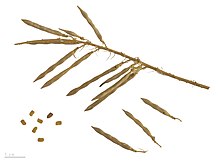| Galega officinalis | |
|---|---|

| |
| Scientific classification | |
| Kingdom: | Plantae |
| Clade: | Tracheophytes |
| Clade: | Angiosperms |
| Clade: | Eudicots |
| Clade: | Rosids |
| Order: | Fabales |
| Family: | Fabaceae |
| Subfamily: | Faboideae |
| Genus: | Galega |
| Species: | G. officinalis
|
| Binomial name | |
| Galega officinalis | |
| Synonyms[1] | |
|
List
| |

Galega officinalis, commonly known as galega[2] or goat's-rue,[3] is a herbaceous plant in the subfamily Faboideae of the legume family Fabaceae.[4] It is native to parts of northern Africa, western Asia and Europe, but is widely cultivated and naturalised elsewhere.[4][2] The plant has been extensively cultivated as a forage crop, an ornamental, a bee plant, and as green manure.[4][5]
G. officinalis is rich in galegine, a substance with blood glucose-lowering activity and the foundation for the discovery of metformin,[6] a treatment for managing symptoms of diabetes mellitus.[7] In ancient herbalism, goat's-rue was used as a diuretic.[8] It can be poisonous to mammals, but is a food for various insects.[4]
- ^ "Galega officinalis L." Plants of the World Online. Royal Botanic Gardens, Kew. Retrieved 14 May 2024.
- ^ a b "Galega officinalis". Germplasm Resources Information Network. Agricultural Research Service, United States Department of Agriculture. Retrieved 8 July 2014.
- ^ BSBI List 2007 (xls). Botanical Society of Britain and Ireland. Archived from the original (xls) on 2015-06-26. Retrieved 2014-10-17.
- ^ a b c d "Galega officinalis (goatsrue)". Invasive Species Compendium, CAB International. Retrieved 2017-12-23.
- ^ Lasseigne, Alex (2003-11-03). "Invasive Plants of the Eastern United States: Galega sp". US Department of Agriculture. Retrieved 2017-12-23.
- ^ Shenfield, G (April 2013). "Metformin: Myths, misunderstandings and lessons from history". Australian Prescriber. 36 (2): 38–39. doi:10.18773/austprescr.2013.017.
- ^ Bailey CJ, Day C (2004). "Metformin: its botanical background". Practical Diabetes International. 21 (3): 115–117. doi:10.1002/pdi.606. S2CID 208203689.
- ^ "Goat's rue". Drugs.com. 2009. Retrieved 23 December 2017.